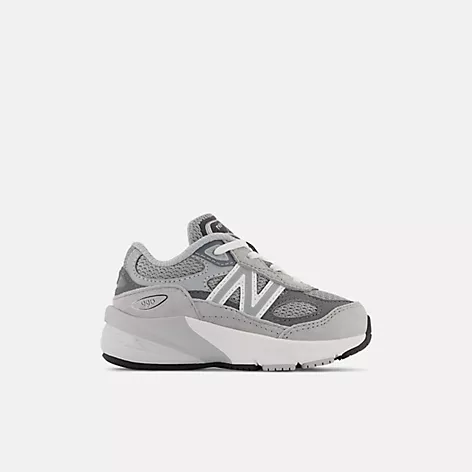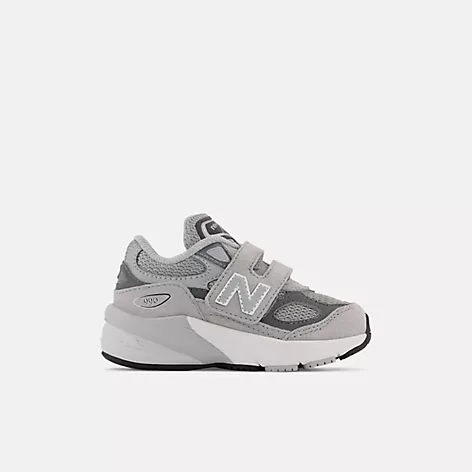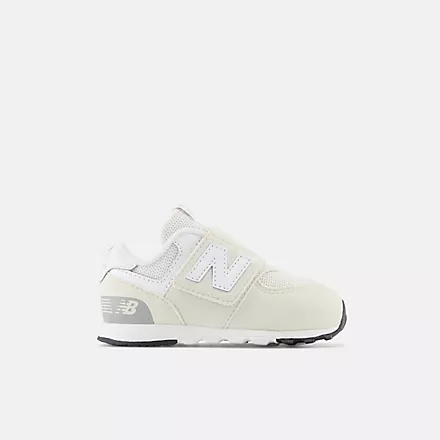At What Age Do Children Start Walking? – Is it Time to Worry?
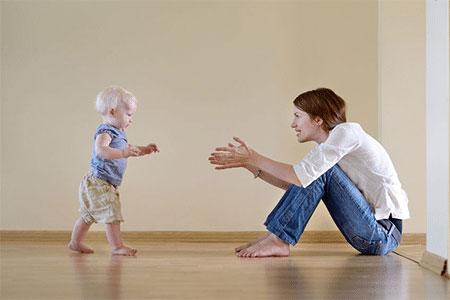
One of the most common questions that parents ask me at the shoe store that I work for is: At what age do children start walking? Most babies start walking by 14 months, but if it’s taking a little longer for your baby to start walking there is no reason to panic. I have seen babies that don’t start walking until they reach 16 or 17 months.
Even if your baby is not walking yet, you may notice that he/she can perform other motor skills with no problem, like standing alone, pulling up on furniture, and bouncing up and down. Some babies are just late walkers. There can be several reasons why it’s taking longer for your baby to learn how to walk, many of which aren’t serious but more related to your baby’s personality.
Keep in mind that babies develop at different rates, but if your baby is not walking by his/her 18 month, you should consult with your pediatrician.
Several parents have asked me if there is something they can do to help their babies walk. There is nothing you can really do to speed up the learning process, but do make sure that you provide your baby with the correct pair of first walking shoes, as they play a key role in providing confidence and balance for your baby.
Let’s first take a look at the different walking learning stages a baby goes through. I have put together a set of dates that will help you get an idea of how the whole process of learning how to walk comes together. Please keep in mind that this is just an estimate and I have come up with these time frames from observing hundreds of different babies learn how to walk at a specialized children’s shoe store that I work for.
12 Months – The Cruising Stage
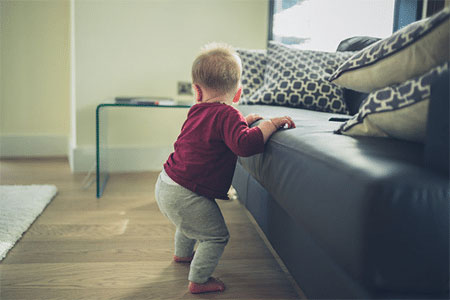
At about 12 months your baby will start to “cruise”, which involves moving from one piece of furniture to another. Cruising is one of the biggest signs that your baby will start walking soon. You might even notice your baby letting go and standing (in the same place) without holding into anything.
Some babies might be already walking by 12 months, but keep in mind that most of them are probably doing it unsteadily. If your babies are still in the cruising stage, it simply means that walking on their own is going to take them a little longer.
Please note that as soon as babies learn how to pull themselves up into a standing position, they will need some help figuring out how to safely get back down again. Show them how to bend their knees so they can sit down without toppling over. Please stay away from baby walkers. The America Academy of Pediatrics (AAP) discourages their use based on safety risk and lack of benefits.
14 to 15 months – Standing Alone
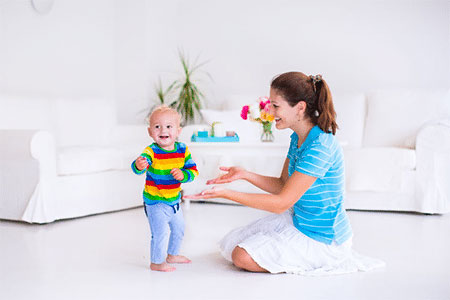
At this stage, your toddler should be able to stand alone. You will probably notice your baby being able to squat down and then stand back up again. By this time most babies might be already walking steadily. They will feel confident enough to hold onto their toys as they walk.
A baby being unable to walk at 14 months isn’t usually indicative of a problem. As long as you notice that your baby can perform other motor skills with no problem, such as standing alone, pulling up on furniture, and bouncing up and down, then these are all signs that your baby’s motor skills are developing.
18 months – Proficient Walkers

Your baby will likely be a proficient walker by 18 months. You will notice them walking all over the place and you will have a hard time keeping up with them!
There is no correlation between how soon your babies walk and how smart they are. The age of babies’ walking is as variable as their personalities.
One common question parents ask me is: When is the right time to get my baby his/her first pair of walking shoes?
This has always been a controversial matter. When babies begin to lift themselves and stand on their own power — this is somewhere between the seventh and tenth month — then it might be time to get them their first pair of walking shoes.
The Best Shoes for Babies Learning How to Walk
Below you can find a selection of the best shoes for babies learning how to walk. These shoes are available in medium (M), wide (W), and extra wide (XW). Disclosure: Some links in this post may be affiliate links and we may receive a small commission (at no extra cost to you) when you click our links and make purchases.
Boys
- Shoe style SRT SM Artie by Stride Rite
- Available in medium, wide, and extra wide widths
- Rounded edges to decrease stumbles and falls
- APMA approved and built for first-time walkers
- Order this shoe a whole size larger than your baby’s current foot size
- Shoe style 2510 Racer by Tsukihoshi
- Fits medium and wide feet
- Heel stabilizer provides lateral stability
- Removable insoles
- Machine washable
- Order this shoe the same size as your baby’s foot size (shoe fits long)
- Shoe style Wes by Stride Rite
- Available in medium, wide, and extra wide widths
- Seamless construction cradle the baby’s natural shape
- Flexible, rounded, slip-resistant soles
- APMA approved
- Order this shoe a whole size larger than your baby’s current foot size
- Shoe style SM Adamby Stride Rite
- Available in medium and wide widths
- Seamless construction cradle the baby’s natural shape
- Flexible, rounded, slip-resistant soles
- Foam padding placed around the ankle collar and under the tongue for an incredibly comfortable fit and feel
- Order this shoe a whole size larger than your baby’s current foot size
- Shoe style Stevie II by See Kai Run
- Fits medium and wide feet
- Rubber outsole is flexible yet durable and provides the needed traction for first steps
- Padded heel and tongue keeps the baby’s feet comfortable
- Wide openings make on and off quick and easy
- Order this shoe half a size larger than your baby’s current foot size
- Shoe style Martin by Stride Rite
- Available in medium and wide widths
- Seamless construction cradle the baby’s natural shape
- Flexible, rounded, slip-resistant soles
- Oversized opening and pull tab on the back offer easy on and off
- Order this shoe a whole size larger than your baby’s current foot size
- Shoe style Kennedy by Stride Rite
- Available in medium, wide, and extra wide widths
- Seamless construction that cradles the foot’s natural shape
- APMA approved
- Oversized opening for easy-on
- Order this shoe half a size larger than your baby’s current foot size
- Shoe style SM Zip Runner by Stride Rite
- Available in medium and wide widths
- Oversized opening for easy on and off
- Flexible, rounded, slip-resistant soles encourage natural motion and help improve balance
- Machine washable
- Order this shoe a whole size larger than your baby’s current foot size
- Shoe style SRT Elliot by Stride Rite
- Available in medium, wide, and extra wide widths
- 100% leather made
- Sensory pods to feel the ground beneath for better traction and grip
- Lace-up closure
- Order this shoe a whole size larger than your baby’s current foot size
Girls
- Shoe style SM Adalyn by Stride Rite
- Available in medium, wide, and extra wide widths
- Oversized opening for easy on and off
- Flexible, rounded, slip-resistant soles encourage natural motion and help improve balance
- APMA approved
- Order this shoe a whole size larger than your baby’s current foot size
- Shoe style Zips Runner by Stride Rite
- Available in medium, wide, and extra wide widths
- Oversized opening for easy on and off
- Padded tongue and collar
- APMA approved
- Order this shoe a whole size larger than your baby’s current foot size
- Shoe style Susie Mary Jane by See Kai Run
- Fits medium and wide feet
- Black patent leather upper with full leather lining and insole
- Awarded the Seal of Acceptance from the American Podiatric Medical Association (APMA)
- Order this shoe half a size larger than your baby’s current foot size
- Shoe style Soft Motion Baby by Stride Rite
- Available in medium, wide, and extra wide widths
- Oversized opening for easy on and off
- Flexible, rounded, slip-resistant soles encourage natural motion and help improve balance
- APMA approved
- Order this shoe half a size larger than your baby’s current foot size
- Shoe style Stevie II by See Kai Run
- Fits medium and wide feet
- Rubber outsole is flexible yet durable and provides the needed traction for first steps
- Padded heel and tongue keeps the baby’s feet comfortable
- Wide openings make on and off quick and easy
- Order this shoe half a size larger than your baby’s current foot size
- Shoe style Thompson by Stride Rite
- Available in medium and wide widths
- Oversized opening for easy on and off
- Flexible, rounded, slip-resistant soles encourage natural motion and help improve balance
- APMA approved
- Order this shoe a whole size larger than your baby’s current foot size
- Shoe style SRT Elliot by Stride Rite
- Available in medium, wide, and extra wide widths
- 100% leather made
- Sensory pods to feel the ground beneath for better traction and grip
- Lace-up closure
- Order this shoe a whole size larger than your baby’s current foot size
- Shoe style Soft Motion Baby by Stride Rite
- Available in medium, wide, and extra wide widths
- Over-sized opening for easy on/off
- APMA approved and built for first-time walkers
- Order this shoe a whole size larger than your baby’s current foot size
- Shoe style StevieII by See Kai Run
- Fits medium and wide feet
- Rubber outsole is flexible yet durable and provides the needed traction for first steps
- Padded heel and tongue keeps the baby’s feet comfortable
- Wide openings make on and off quick and easy
- Order this shoe half a size larger than your baby’s current foot size
Keep in mind that shoes come into play when you take your baby to play outside, as it’s important to allow them to go barefoot around the house for healthy foot development. Going barefoot improves balance and coordination.
If your baby is not walking by 18 months, then it’s time to talk to your pediatrician. There are other conditions that might be interfering with your baby’s ability to learn how to walk such as low muscle tone and certain genetic or birth conditions that have a direct impact on the development of the nervous or muscular systems.
Keep in mind that 2 other factors might be causing a delay in your baby walking:
➡️ Personality: Babies who are easy-going and content tend to just lie on their back and entertain themselves, which leads them to start walking late.
➡️ Environment: A baby who has been sick for a long period of time — which involved lying down or hospital stays — may also start walking late.
Has Your Baby Been Diagnosed with Low Muscle Tone?
While there could be several reasons why your baby is unable to walk, the one I am most familiar with is having a condition called hypotonia or low muscle tone. If your baby has been diagnosed with low muscle tone there are certain steps that you can take to improve posture and coordination, as well as strengthen the muscles around the joints of the legs so they provide more support and stability.
A baby might be diagnosed with low muscle tone for the following reasons:
- Your baby’s muscles appear to be less firm than usual.
- Your baby appears to be floppy and to have loose joints.
- Your baby appears to be less alert and has poor posture.
In this case, you will need to provide a pair of shoes to support your baby’s feet (in particular their ankles), to help them stabilize themselves. There is one particular shoe style made by Stride Rite that is the one that most physical/occupational therapists recommend for most babies who are having a hard time learning how to walk.
If your baby has been diagnosed with low muscle tone, take a look at the selection of shoes below. These shoes are going to help improve posture and coordination, as well as strengthen the muscles around the joints of the legs so they provide more support and stability.
The Best Shoes for Babies with Low Muscle Tone
These shoes are available in different widths such as medium (M), wide (W), and extra wide (XW). Keep in mind that most babies have wide or extra wide feet, so choose your baby’s shoe width accordingly.
Lace-Up Closure
- New Balance shoe style 990v6
- Fits toddlers with medium, wide, or extra wide feet
- Strong rubber outsole and cushioned midsoles
- Suede/mesh upper provides durability and breathability
- Order this shoe half a size larger than your toddler’s current foot size
- New Balance shoe style 990v6
- Fits toddlers with medium, wide, or extra wide feet
- Strong rubber outsole and cushioned midsoles
- Suede/mesh upper provides durability and breathability
- Order this shoe half a size larger than your toddler’s current foot size
- Stride Rite shoe style Emilia
- Fits toddlers with medium, wide, or extra wide feet
- Strong rubber outsole and a cushioned midsole
- 100% leather made
- Order this shoe a whole size larger than your toddler’s current foot size
- Stride RIte shoe style Elliot
- Fits toddlers with medium, wide, or extra wide feet
- 100% leather made
- Seamless construction that cradles the foot’s natural shape
- Order this shoe a whole size larger than your toddler’s current foot size
- Stride RIte shoe style Elliot
- Fits toddlers with medium, wide, or extra wide feet
- 100% leather made
- Seamless construction that cradles the foot’s natural shape
- Order this shoe a whole size larger than your toddler’s current foot size
- New Balance shoe style 990v6
- Fits toddlers with medium, wide, or extra wide feet
- Suede/mesh upper provides durability and breathability
- Order this shoe half a size larger than your toddler’s current foot size
- New Balance shoe style 2022
- Fits toddlers with medium or wide feet
- Suede/mesh upper provides durability and breathability
- Order this shoe half a size larger than your toddler’s current foot size
- New Balance shoe style 990v6
- Fits toddlers with medium, wide, or extra wide feet
- Strong rubber outsole and cushioned midsoles
- Suede/mesh upper provides durability and breathability
- Order this shoe half a size larger than your toddler’s current foot size
Velcro Closure
- Timberland Tracks H&L Boot
- Fits toddlers with medium or wide feet
- Breathable textile lining
- Stable base of support with firm heel counters
- Order this shoe a whole size larger than your toddler’s current foot size
- Saucony Cohesion
- Fits toddlers with medium or wide feet
- Heel grid system for stable cushioning
- Compression molded EVA footbed for comfort
- Order this shoe a whole size larger than your toddler’s current foot size
- New Balance style 990v6
- Fits toddlers with medium, wide, or extra wide feet
- ABZORB midsole absorbs impact through a combination of cushioning and compression resistance
- Removable insoles
- Extra deep
- Order this shoe a half size larger than your child’s current foot size
- New Balance style 574
- Fits toddlers with medium, wide, or extra wide feet
- Generous toe box and instep to accommodate and support your toddler walker’s needs
- Rubber outsole pods designed to stand up to daily wear and tear
- Extra deep
- Order this shoe a whole size larger than your toddler’s current foot size
- Memo style Gabi
- Fits toddlers with medium or wide feet
- Thermoplastic asymmetric stiff heel counter for proper feet protection and stabilization
- Stiff and high ankle support for toe walkers
- Order this shoe half a size larger than your toddler’s current foot size
- Memo style Gabi
- Fits toddlers with medium or wide feet
- Thermoplastic asymmetric stiff heel counter for proper feet protection and stabilization
- Stiff and high ankle support for toe walkers
- Order this shoe half a size larger than your toddler’s current foot size
- New Balance style 990v4
- Fits toddlers with medium or wide feet
- Generous toe box and instep to accommodate and support your toddler walker’s needs
- Extra deep
- Order this shoe a whole size larger than your toddler’s current foot size
What Makes the Shoes I Recommended Effective for Babies with Low Muscle Tone?
These are the 4 most important features that the shoes I recommended provide for babies with low muscle tone:
1️⃣ Firm Heel Counter: This feature helps strengthen and straighten your baby’s ankle.
2️⃣ Substantial Outsole: This feature helps straighten your babies’ feet by preventing them from collapsing and turning inwards. This feature also helps improve your baby’s overall posture and stability.
3️⃣ Flexible rubber sole improves traction and prevents slips and falls.
4️⃣ 100% leather made.
Are Any Other Shoe Choices Available?
Do not hesitate to contact me directly at my email if you have any further questions or if you need a different selection of shoes.
Once your babies are steady and walking on their own, it’s best to provide them with sturdy and supportive shoes. Early walkers are active, so you’ll want baby walking shoes with good shock absorption and durable soles.




















